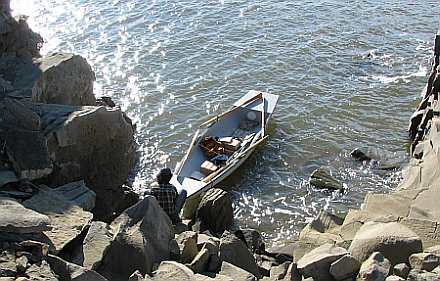
Carl Noe's RB42. This is the best beach he could find.
Contents:
Contact info:
Jim Michalak
118 E Randall,
Lebanon, IL 62254Send $1 for info on 20 boats.
Jim Michalak's Boat Designs
118 E Randall, Lebanon, IL 62254
A page of boat designs and essays.
(1November10)This will review the Sail Oklahoma 2010 messabout. The 15 November issue will continue the topic.
THE BOOK IS OUT!
BOATBUILDING FOR BEGINNERS (AND BEYOND)
is out now, written by me and edited by Garth Battista of Breakaway Books. You might find it at your bookstore. If not check it out at the....ON LINE CATALOG OF MY PLANS...
...which can now be found at Duckworks Magazine. You order with a shopping cart set up and pay with credit cards or by Paypal. Then Duckworks sends me an email about the order and then I send the plans right from me to you.

|
Left:
Carl Noe's RB42. This is the best beach he could find.
|
|
|
Sail Oklahoma a
BACKGROUND...Mike Monies has a home and boatshop a few blocks from a free ramp on Lake Eufala in eastern Oklahoma. You might remember him as the Laguna builder/sailor who completed the Everglades Challange, the OXB130 and the Texas200 in his Laguna this year. Anyway, he was thinking why not have a messabout at Lake Eufala? Why not on Columbus Day weekend? Why not call it Sail Oklahoma? So he did it.
BUT FIRST AN INTRODUCTION....
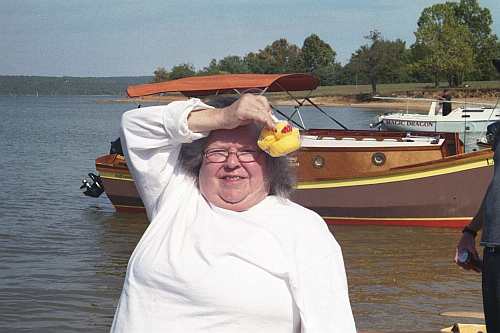
This is Jackie Monies, Mike's wife. I think she has the brains and energy behind most of this. Tireless, she kept us all fed and busy and happy. Thanks for all, Jackie! I'll explain the rubber duckies in her hand later....
SECOND, GETTING THERE...
My old vehicle was not looking forward to a 500 miles drive to Oklahoma. Not a problem. Mike's daughter Michele and her husband Brandon live 60 miles west of me in Missouri and had room for me and my camping gear. Besides, they had a new niece to see for the first time in Tulsa which is sort of near Eufala and they were going to the messabout anyway. So early Friday morning I drove to their house and hopped on board. All gear went in a cartop carrier and three dogs went in the stern.
The dogs quickly fell asleep as we flew down I44 from St Louis to the Tulsa area. Brandon had just returned from two weeks in Haiti where he was on a medical mission. Lots to talk about. He makes and fits artificial limbs so he was no tourist there. The hours and the miles flew by as I learned the technology and the conditions in Haiti.
On the outskirts of Tulsa I was handed off to old Gene at the Phillips66 truckstop. Brandon and Michele were continuing to their baby rendevous. Gene lives near the truckstop and was going to the messabout towing a camping trailer and with a spanking new Piccup Pram in the bed of his truck. Well, actually it was two years old but had never been in the water. Neither had Gene. He had taken a class in sailing but had never really done it. The realities of life had prevented him from lauching the Piccup until now. So we were off down to the lake. Gene and wife made their living making ceramics which they sold mostly at fairs. And as we trucked on south to the lake I learned another technology to the point where we talked so much we missed a turn and had a bit of an extended detour. No problem really, we got there around dark and found the Monies' homestead well populated with tents, trailers and boats since some folks had arrived there even on Thursday.
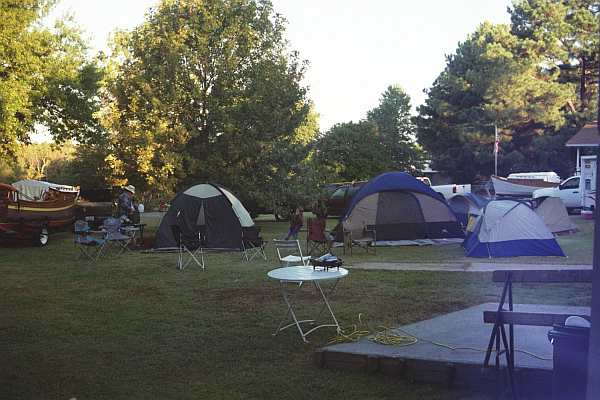
We check the place over a bit, including a pass by the ramp area to see some messabouters who had already launched, and get in on the first Monies' feed, all excellent. Recall if you will that the Monies women kept us all from starving on the Texas 200. And contrast this to my own Rend Lake messabout which is close to a bread and water affair. Then many chats, meeting new folks, getting a sleep spot and off to bed.
I should mention here that the weekend weather was about perfect for the event. Maybe 80 degrees in the afternoon and sun. My experience with over 20 years of Rend Lake messabouts is that success/failure is almost a matter of weather alone. So off to a great start in Oklahoma.
SATURDAY...
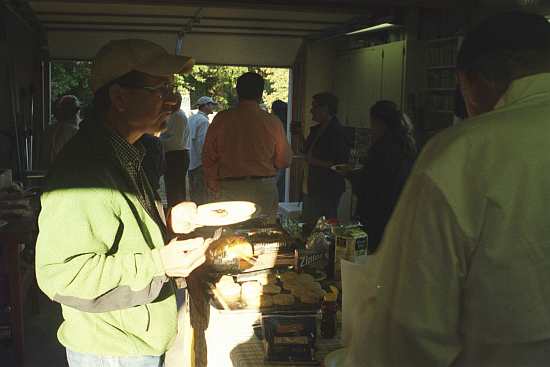
Wake up. Mike's large work shop is the meeting place for everyone but first another feed! Chuck and Sandra Leinweber of Duckworks have driven up from Texas. That is Chuck above on autofeed. More chatting and then down to the ramp, within an easy walking distance, to see the spread with new arrivals.
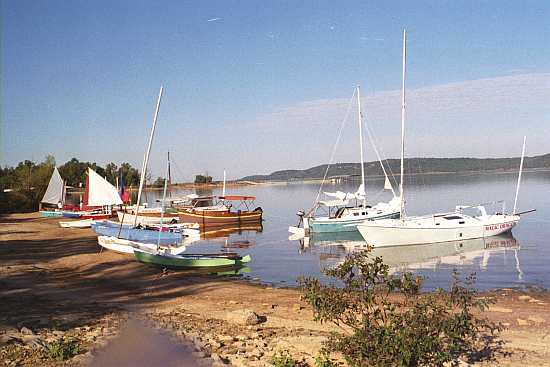
Nice variety here. Lots of Puddle Ducks here since there was an effort to have enough around to make this event the site of next year's Puddle Duck world championships. I believe there were 13 in attendance and they all got wet.
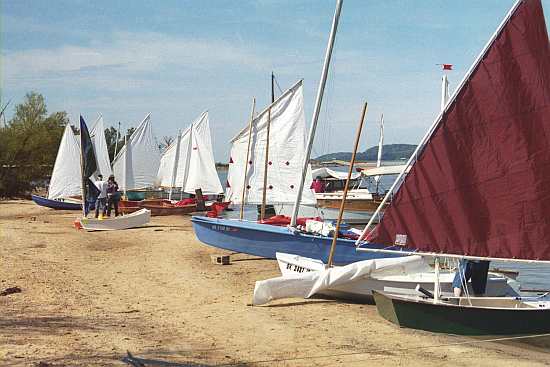
But other boats are here too. Two nice SkiffAmericas. The Shearwater and a few Potters made up the factory boats. Lots of dinghies. Mike had a take apart dinghy plus the Bolger Cartopper that he used to complete the 2009 Texas200. Mike also had three PDR's there, two Storer boats and a Welsford boat. There's a Bolger Elegant Punt, one of the very first "Instant boats".
A pretty lake, huh? Yes and not at all crowded. Very big and with lots of arms to explore. Check out the beach! All natural sand as far as I could tell. I waded out over waist deep a few times and the slope is gentle and the bottom the same sand you see here all the way out. Wonderful.
What's this....Gene is setting up his Piccup Pram for its first ever float. In its white paint it reminded me of my own prototype Piccup back when it was new and still white (I still have it, camoflag paint now). I helped him rig it and probably told him to forget everything he'd heard at the sailing school. Conditions were at that time perfect for testing a new boat and sailor.
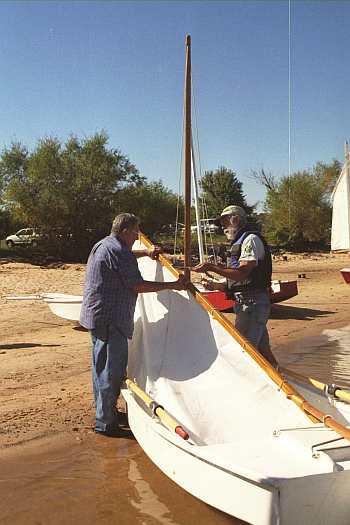
Here he is doing the last fussing. Behind him is Richard Spelling's veteran Bolger Navigator. To the right is Monies' new Welsford PDR.
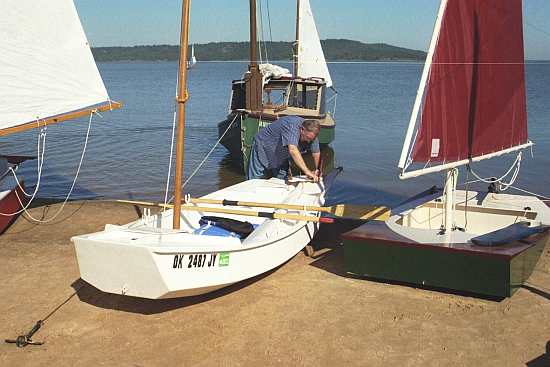
He found a lady to christen the Piccup with a bottle of water and then into the water with it. (Looks like Spelling has decided to get his boat the hell out of the way, all things considered.)
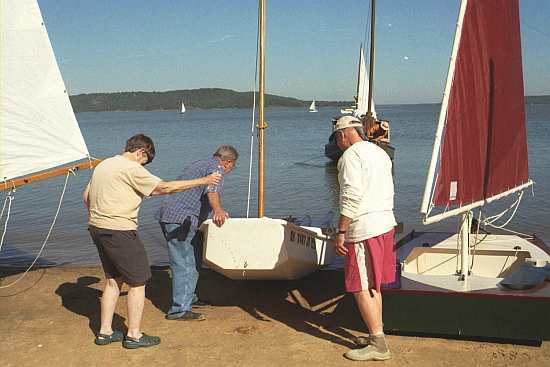
I'll finish this little episode although it took a day to play out. Once in the water I took it for a row and declared it fit. Gene took it for a row. Then I took it for a sail and found the leeboard would not swing all the way down. Perhaps the wood had swelled up a bit which is usually what happens. Usually I have found the leeboard should be rattling loose in all positions except full down, where a bit of a jam fit is nice. So some work with a rasp was required to fine tune. Then it was declared fit for duty. Gene took it out on Sunday morning for its and his first sail. Light wind off shore so he got off the beach easily and then cruised back and forth along the shore. We yelled instructions to him as best we could but he'd told me he'd left his hearing aid safe at home so I suspect he didn't benefit much from our instructions. But in light wind the beginner is OK and he sailed for an hour or so, then tacked back to the beach until the boards hit bottom, then got out the oars and to dry ground. Success! A new boat and a new boater! Thanks, Gene.
PLAN FOR SATURDAY...
There was an activity planned for Saturday. We were to sail about 6 miles to a park picnic area for lunch! Here is a photo of Chuck and Mike steeling themselves for the picnic trip...
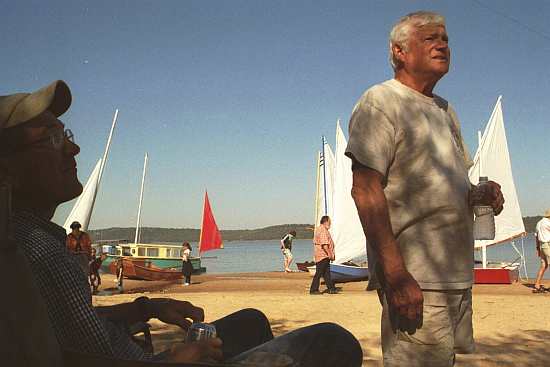
It was downwind and the wind was rising a bit so off we went. I hitched a ride with George Fulk on his Mayfly16. (Hey, George was working in the Peace Corp in Chile when they had the big revolution/military coup but luckily he didn't "disappear" like some of his fellows...)
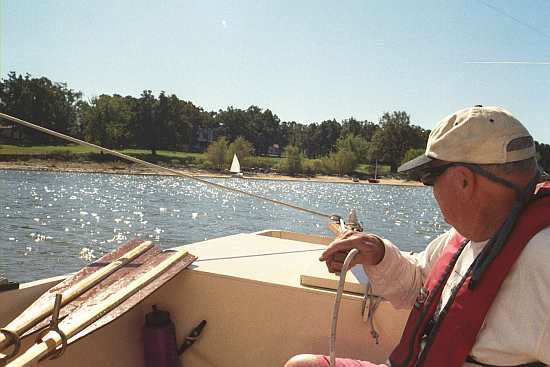
A nice trip for us. I suppose it took about an hour and a half to get there, all nice downwind sailing. But arriving at the beach you look back from where you came and see 6 miles of windward sailing and some whitecaps. Here is George taking the sail down on Mayfly16. The larger boats avoided beaching for the most part. The little guys usually pulled up on the beach and headed their boats into the wind.
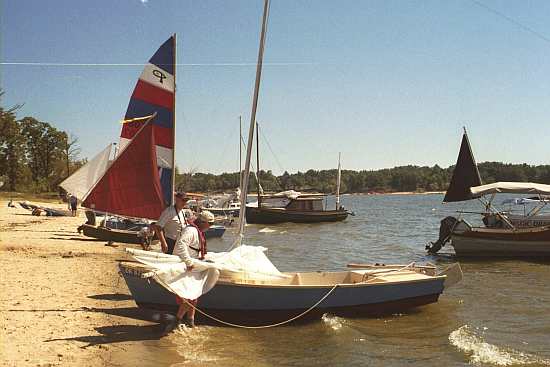
Then off to another buffet lunch amongst the shady pavilion overlooking the beach!
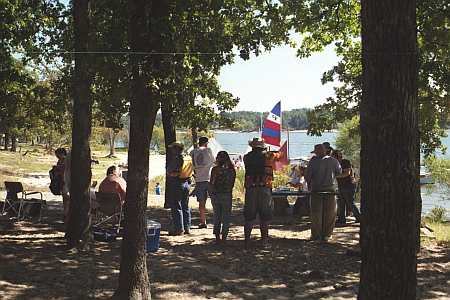
Picnic done it was time to pay the piper and face the whitecaps. Everyone had a different technique. Haven't mentioned this yet but Chris and Kathy brought their Caroline EZbake up from Texas. They got to the picnic a little late because they were still working on the new rig after they arrived. You may have seen EZbake with an experimental three masted junk rig. Chris said it would not sail to windward so he was converting it to the designed balanced lug sail. As George and I were leaving the beach to go to the picnic the EZbake crew was still at the ramp pounding grommets into their just finished polytarp sail, so we were still experimenting.
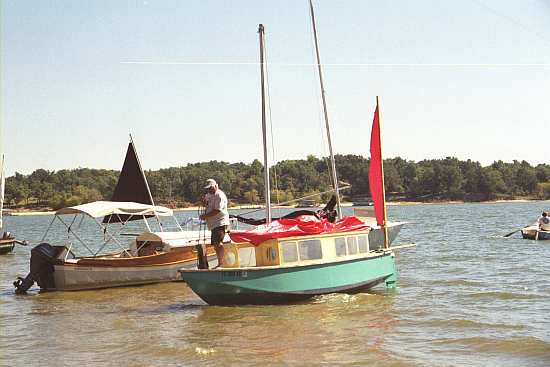
I hitched a ride on the Caroline for the return trip. Now, here is how I usually figure time on a trip like this. For every hour you ride downwind, you will beat about three hours into the same wind to get back. Remember that a tacking boat will go about 2 miles for every mile needed to windward, sometimes more. And your speed will usually be slower, sometimes a lot slower. Then you are facing 12 miles at 3 or 4 mph (if you are lucky). So we were facing a three or four hour return. And thus it was. We got off the beach and spent a while tweaking the sails, remember that this sail had never been mounted before. I found the Caroline to be very comfortable so that would be no problem. Lots of room inside and nothing in the way.
After a couple of hours we sailing more or less tack for tack with some other boats we noticed one of our fellows was getting left far behind, he had sort of made no progress into the chop in the hour that we were watching. Kathy said, "Maybe we should give him a tow." Going back to him would entail losing most of our to windward progress. "Then we could motor all the way back," says I. So we did that. He only had a trolling motor so we did the right thing.
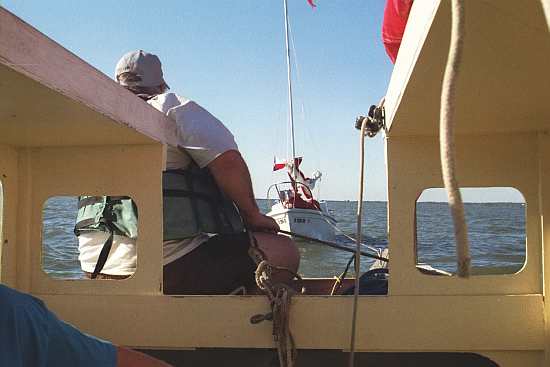
As we motored back (which took at least an hour) the wind was dropping and some folks weren't going to get back under sail at least. Here we are after the return, sun getting low...
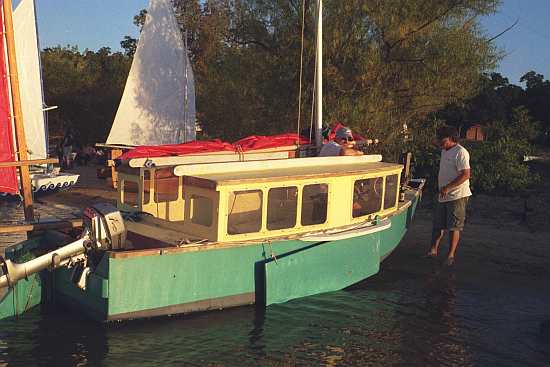
A note about Chris's Caroline. He has enlarged his stern well to be the full width well I normally like to use. But it won't usually work with a Birdwatcher because with this style cabin the tiller must run under the stern deck and into the cabin. If you do that with a large full width motor well you will end up with a long slot for the tiller which is a danger in a knockdown since water could come through it and swamp the cabin. So what you have to do, which is what I did on the Petesboat design and which Chris reinvented here, is to put a short control arm on the side of the rudder and control that with a push/pull stick that runs into the cabin through a small hole in the aft bulkhead on centerline. So this boat has a simple push/pull stick control which takes a while to get used to and has less precise control since the control arm is maybe 18" long instead of maybe 60" long for the standard tiller. Chris had it all figured correctly and feels like I do that the only cure is a geared tiller linkage like I drew on Petesboat. So far Chris has opted for simplicity but in the back of his mind......
Well, the wind failed totally as the sun was setting. Mike has a Boston Whaler with 30 hp and used it to gather up the becalmed. But there were others who paddled and rowed in. Here is Stan in another Piccup Pram pulling Chuck in the Welford PDR. Two Piccups together at the same meet! Never happened before, I think.
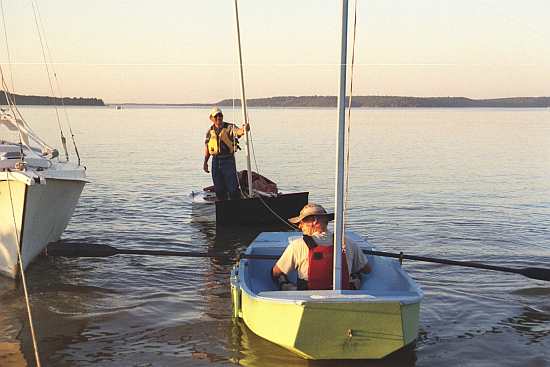
The sun set slowly in the west.
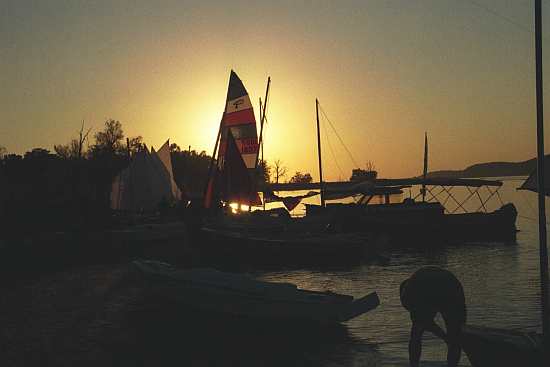
Then back to the homestead and the supper buffet. Another great feast! No weight loss on this trip. Then off to sleep for the next day.....
Piccup Pram
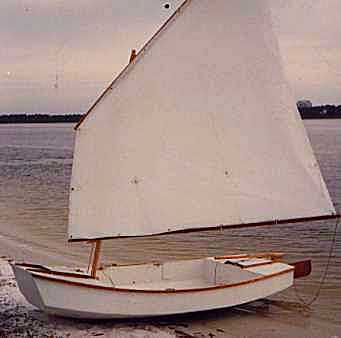
PICCUP PRAM, SAIL/ROW PRAM, 11' X 4.5', 90 POUNDS EMPTY
Piccup Pram was the first boat of my design to get built, back in 1990, I think. I still have the prototype and use it regularly. I designed it to be the best sail/row boat I could put in the back of my short bed pick up truck. But I found it to be a good cartopper, too. It has capacity and abilities I had previously thought impossible in a 90 pound cartopper. The photo above shows the original 55 square foot sail on Pensacola bay a long time ago. Piccup is a taped seam multichine hull which can take a fair amount of rough water.
Piccup continues to be one of my most popular designs and I get nice photos from builders. Here is one of Richard Donovan hoping for more wind up in Massachusetts.
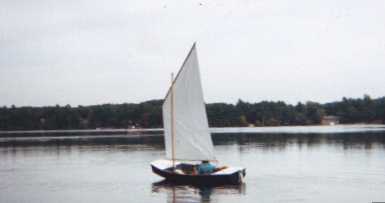
Richard's Piccup has the larger 70 square foot sail that prefer myself. It's the same as the original but is 2' taller. This balanced lug sail sets on a 12' mast and rolls up easily for storage on its 9' yard and boom. The idea was to be able to store the rig easily in the boat during rowing and it works. There is a pivoting leeboard and kickup rudder on the boat and they can be left in place raised while rowing. Converting to full sail takes a couple of minutes as you step the short mast, clip on the halyard and tack lines, hoist the sail, lower the boards, and off you go. And the balanced lug sail reefs very well although reefing any small boat is best done on shore.
Here is a Piccup by Vince Mansolillo in Rhode Island, a nice father/son project. Piccup will be large enough to hold both of them. You can see the large open frameless cockpit, large enough for sleeping. And you see the buoyancy/storage boxes on the end.
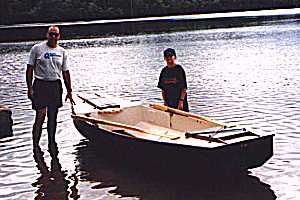
But Piccup will take two adults as seen in the photo of Jim Hudson's boat. Jim's boat has a polytarp sail as does my own Piccup.
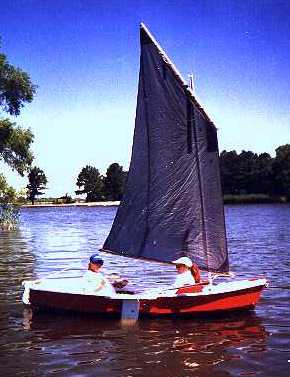
These boats have proven to be good for sail rig tinkerers (be sure to read and apply the Sail Area Math essay before starting). Here I am in Piccup with a polytarp sharpie sprit sail. The rig is different from the originals but the hull here is totally unchanged (except for paint) from the original shown on the beach at Pensacola.
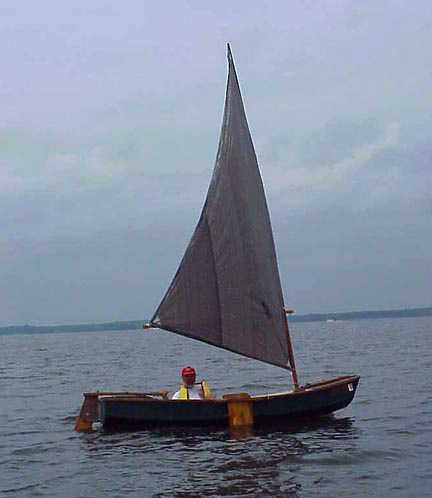
I think my own Piccup has had about six rigs of different sorts and was always the test bed for the polytarp sail experiments. But, hey!, that's nothing compared to the tinkering Reed Smith did with his out in California. Here is his Piccup rigged as a sharpie sprit yawl!

Here is Rob Rhode-Szudy's yawl rig Piccup that was featured in his essays about building Piccup that you can access through the old issue links.

Here is another by Doug Bell:

This one is by Jim Islip:
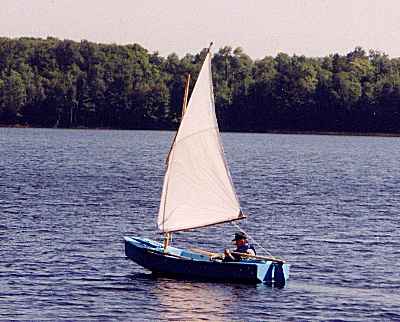
And this one by Ty Homer:
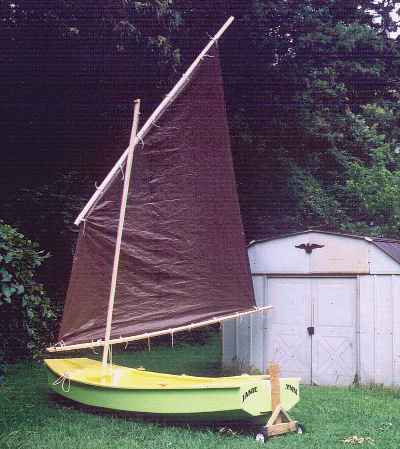
Piccup Pram uses taped seam construction from five sheets of 1/4" plywood.
Plans for Piccup are still $20.
Prototype News
Some of you may know that in addition to the one buck catalog which now contains 20 "done" boats, I offer another catalog of 20 unbuilt prototypes. The buck catalog has on its last page a list and brief description of the boats currently in the Catalog of Prototypes. That catalog also contains some articles that I wrote for Messing About In Boats and Boatbuilder magazines. The Catalog of Prototypes costs $3. The both together amount to 50 pages for $4, an offer you may have seen in Woodenboat ads. Payment must be in US funds. The banks here won't accept anything else. (I've got a little stash of foreign currency that I can admire but not spend.) I'm way too small for credit cards.
I think David Hahn's Out West Picara is the winner of the Picara race. Shown here on its first sail except there was no wind. Hopefully more later. (Not sure if a polytarp sail is suitable for a boat this heavy.
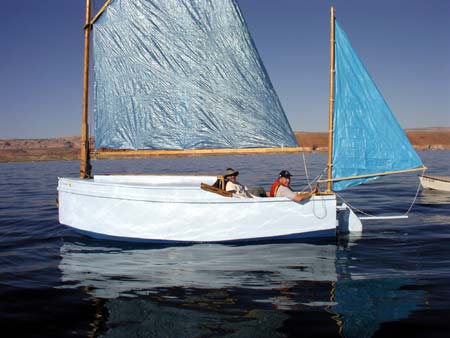
Here is a Musicbox2 I heard about through the grapevine.
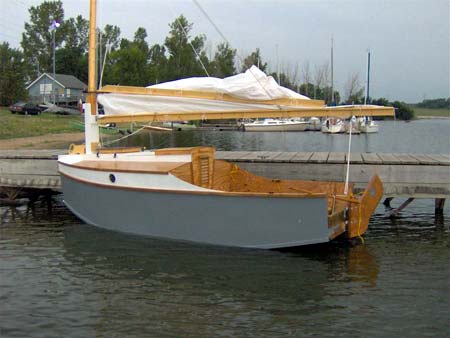
This is Ted Arkey's Jukebox2 down in Sydney. Shown with the "ketchooner" rig, featuring his own polytarp sails, that is shown on the plans. Should have a sailing report soon.
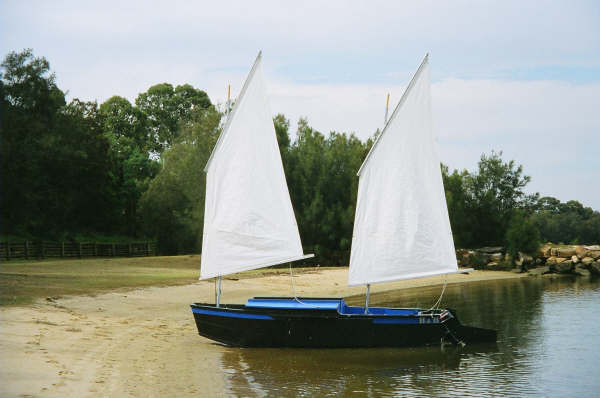
And the Vole in New York is Garth Battista's of www.breakawaybooks.com, printer of my book and Max's old outboard book and many other fine sports books. Beautiful job! Garth is using a small lug rig for sail, not the sharpie sprit sail shown on the plans, so I will continue to carry the design as a prototype boat. But he has used it extensively on his Bahamas trip towed behind his Cormorant. Sort of like having a compact car towed behind an RV.

A view of the Caroline prototype showing a lot of the inside, crew on fore deck. Beautiful color:
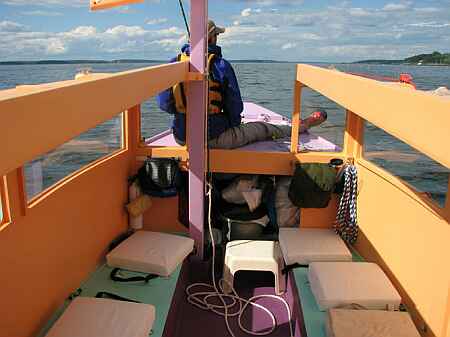
And here is another making I think its maider voyage in the Texas 200. (I'm told the Chinese rig will be replaced by the blueprint rig.)
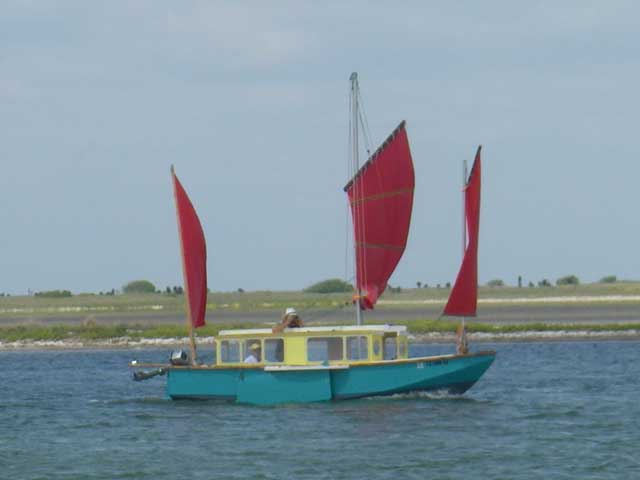
I gotta tell you that on the Caroline bilge panels I made an error in layout and they are about 1" too narrow in places on the prototype plans. I have them corrected but it always pays, even with a proven design, to cut those oversized and check for fit before final cutting.
And a Deansbox seen in Texas:
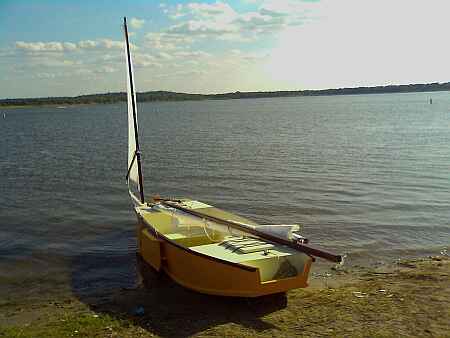
The prototype Twister gets a test sail with three grown men, a big dog and and big motor with its lower unit down. Hmmmmm.....
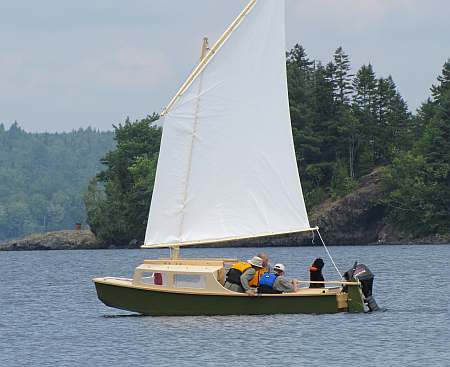
AN INDEX OF PAST ISSUES
Hullforms Download (archived copy)
Plyboats Demo Download (archived copy)
Brokeboats (archived copy)
Brian builds Roar2 (archived copy)
Herb builds AF3 (archived copy)
Herb builds RB42 (archived copy)